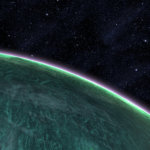System Specs:
- Stellar Mass: N/A Sol Masses
- Stellar Class: N/A
- Luminosity: N/A Sol
- Planets: 5
- Moons: 0
- Asteroid Belts: 2
- Asteroids: 2
- Objects: 0

It is probably named for the classical Minoan (and, later, Greek) city of Knossos. Fittingly, all the planets in the Knossos system (with the exception of Therum) are named for ancient Minoan cities and monuments. Furthermore, among the Greek city states the four systems in the Artemis Tau cluster are named after, Knossos is by far the oldest; predating the other three by several thousand years. This is likely a nod to the fact that the ancient Prothean ruins at the dig site are located in this system.
–
Planets Directory:
- Phaistos
- asteroid belt
- Therum
- Zakros
- Armeni
- asteroid belt
- Archanes
–
Phaistos:

- Orbital Distance: N/A AU
- Orbital Period: 0.3 Earth-years
- Keplerian Ratio: N/A
- Radius: 4,238 km
- Day Length: 57.2 Earth-hours
- Atmospheric Pressure: 0.27 atm
- Surface Temp: 551 °C
- Surface Gravity: 0.63 g
- Mass: 0.276 Earth-masses
Phaistos is a small terrestrial with a trace atmosphere of carbon dioxide and xenon. The surface is scorching hot, and mainly composed of sulphur and various silicates. There is little of interest on this desolate world.
–
Therum:

- Orbital Distance: N/A AU
- Orbital Period: 6.4 Earth-years
- Keplerian Ratio: N/A
- Radius: 6,724 km
- Day Length: 28.3 Earth-hours
- Atmospheric Pressure: 0.68 atm
- Surface Temp: 59 °C
- Surface Gravity: 1.12 g
- Mass: 1.1236 Earth-masses
- Colony: human
Capital: Nova Yekaterinburg, founded 2167, population 34,000
Therum is a distant but rich industrial world claimed by the human Systems Alliance. Its plentiful heavy metals have fueled the recent manufacturing boom on Earth. Core samples rich with the fossils of simple silicon-based organisms indicate Therum was more habitable in the past than it is at present. Perhaps this explains the many Prothean ruins dotting the surface, most of which have been looted by mining corporations.
–
Zakros:

- Orbital Distance: N/A AU
- Orbital Period: 33.9 Earth-years
- Keplerian Ratio: N/A
- Radius: 4,572 km
- Day Length: 45.6 Earth-hours
- Atmospheric Pressure: 0.40 atm
- Surface Temp: -71 °C
- Surface Gravity: 0.4 g
- Mass: 0.204 Earth-masses
Zakros is a terrestrial world with a nitrogen-methane atmosphere containing trace amounts of hydrocarbons. Its frigid surface is mainly composed of water ice and hydrocarbon slush. Most of the surface is not solid enough to support the full weight of a landed ship. If approach is necessary, use shuttles or keep the ship’s mass effect envelope up.
–
Armeni:

- Orbital Distance: N/A AU
- Orbital Period: 151.3 Earth-years
- Keplerian Ratio: N/A
- Radius: 6,077 km
- Day Length: 57.8 Earth-hours
- Atmospheric Pressure: 0.18 atm
- Surface Temp: -168 °C
- Surface Gravity: 0.8 g
- Mass: 0.721 Earth-masses
Armeni is a terrestrial world with an unusually thin atmosphere of krypton and xenon. Its surface is composed of silica with deposits of carbonaceous materials. The initial flyby probe of Armeni detected multiple areas at the equator with oddly regular surface protrusions.
Closer investigation revealed these as millions of elaborate crypts a few meters below the surface, left by a long-extinct spacefaring species called the zeioph. Many human universities wish to perform archeological excavations. Council law holds grave sites as sacrosanct, however, and the matter has been tied up in court for a decade.
–
Archanes:

- Orbital Distance: N/A AU
- Orbital Period: 470.2 Earth-years
- Keplerian Ratio: N/A
- Radius: 14,549 km
- Day Length: 16.2 Earth-hours
- Atmospheric Pressure: N/A atm
- Surface Temp: N/A °C
- Surface Gravity: N/A g
- Mass: N/A Earth-masses
- Satellites: >1
A small hydrogen-helium gas giant, Archanes has been developed as a full-featured, if modest, stopover for ships hauling refined materials from Therum. In addition to a powerful magnetic field to dump drive charge, Archanes has a largely automated infrastructure of helium-3 refining and deuterium mining on its many water ice moons.
–
–
video






